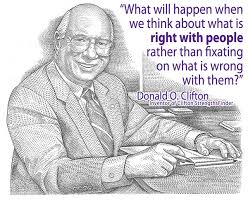
We have known for millennia that working from a position of strength creates a distinct performance advantage. The Old Testament story of David and Goliath is not so much a story of good triumphing over evil as it is a story of strength being greater than might.
OK, so how does that work, and what am I even talking about? It is all too common and very mistaken to associate strength with brute force. Strength is the ability to harness natural talent through the development of skill. Brute force is power applied to overwhelm. Brute force works but it is not easily adaptable in a changing environment.
This is what the D vs G story is trying to tell us. Poor Goliath comes to the fight with brute force and nothing else, after all, if you can create more force it is easy to beat down an opponent who has not learned how to harness their natural talents. David, half of the size of Goliath, comes to the fight with highly refined natural talents developed through many years of deliberate practice.
So what are these Strengths that David brings with him? Sure, he’s great with a sling, that’s helpful, but that’s not where the Strengths come in. The Strengths that make his success possible are his Self-Assurance, Adaptability, Command, Responsibility and Belief. By using these Strengths he is able to maintain composure, move with the situation, take charge, know that he has the capability and understand that the cause that he is fighting for is based on a set of values that he knows to be true. Each one of these Strengths requires skill development and practice to master. Each one of these Strengths supports his technical capability with the sling, allowing him the presence to use the tool to maximum advantage.
Game, set and match.
Nice take on the story, so what? Well, skipping forward to quasi-modern times and the (more or less) real world, a guy named Don Clifton wondered what it would be like if we were to work on developing strengths rather than trying to eliminate or prop up weaknesses. Don’s interest in strengths came out of his work in the newly developing field of positive psychology. Don’s work was not something that he put together over a few weeks. 30 years into his research the prototype was born. Now, a little over 10 years on, we can work with a finished product.
 What Don did was look at the performance of successful people in any field and interview them extensively. This gave Don a mountain of data. He then sifted through the data and came up with a collection of talent areas that he called Strengths. He identified 34 talent areas or Strengths. He sorted these into 4 performance sectors or Domains. He now had an outcome tool. From his interviews he captured the perspectives that identified each of the strengths and from those perspectives he created an assessment tool that he called the StrengthsFinder (now known as CliftonStrengths®).
What Don did was look at the performance of successful people in any field and interview them extensively. This gave Don a mountain of data. He then sifted through the data and came up with a collection of talent areas that he called Strengths. He identified 34 talent areas or Strengths. He sorted these into 4 performance sectors or Domains. He now had an outcome tool. From his interviews he captured the perspectives that identified each of the strengths and from those perspectives he created an assessment tool that he called the StrengthsFinder (now known as CliftonStrengths®).
Identifying talent is one thing. Doing something with it is quite another. Talent represents potential but that is all that it represents. Without intentionally applying that talent to the daily vagaries of life the talent goes mostly unused and remains in an undeveloped state. In order to build that talent out into full blown Strengths, the Strengths based coaching program was created.
Strengths based coaching uses the output of the CliftonStrengths® assessment to help individuals and teams become aware of their most important talent areas. Once that discovery is made the process of applying the talents can be started. As the application process unfolds the achievements are used to fuel and accelerate the application of action. This causes the development of the talent areas creating real Strengths that become the foundation for performance improvement.
Some of the features of talent areas make this development process very enjoyable. When we are working in our talent areas we are more efficient, we are more confident, and we are more productive. It’s easy, we like it and we get things done. When our talents become full-blown strengths we act with more determination and greater purpose. When we act with more determination and greater purpose we perform at a higher level. In effect, we create a cascade to high performance that delivers lasting results.
Strengths based development is based on the following paradigm.
-
There is a strong connection between:
-
who people are and what people do best;
-
what people do best and how people feel;
-
how people feel and how people perform.
-
Or, to put it into the words of the athletes that I work with, “We love working on what we are good at, it’s fun!”
